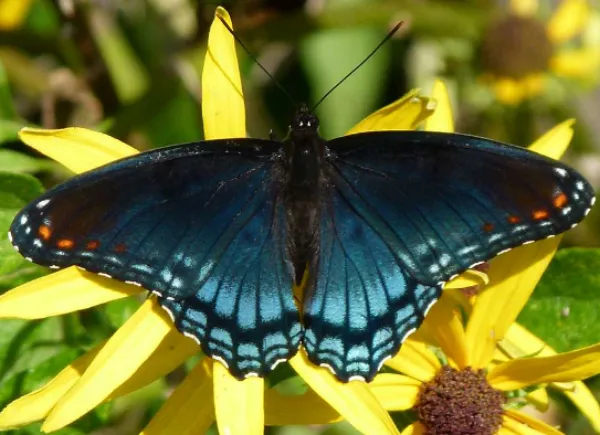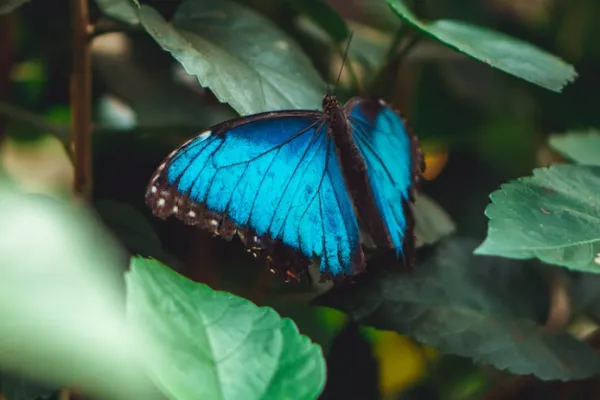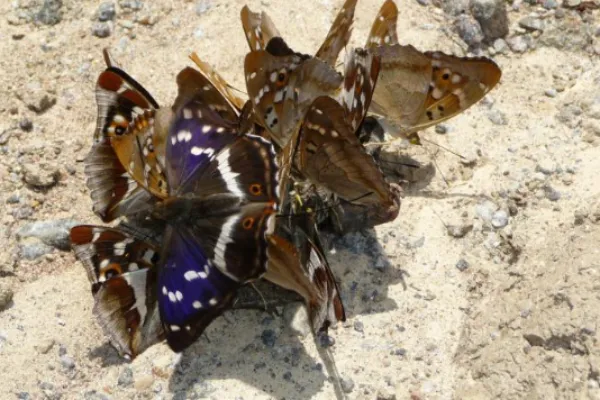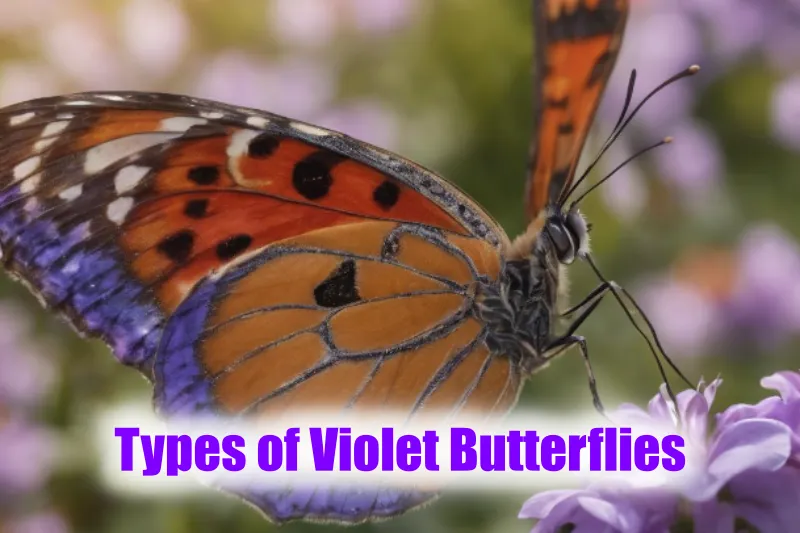In my opinion, violet as a color is often underestimated. Some of us may struggle to differentiate between a shade of purple and a shade of violet. That’s why I believe it’s important to get the color theory right in our article on violet butterflies.
While researching to find the best-suited butterflies for this criterion, I realized that even though there are several violet butterflies, only a few truly meet the criteria.
So, here, I’ve compiled a comprehensive list of 7 types of violet butterflies for all you nature enthusiasts!
7 Types of Violet Butterflies
1) Red-Spotted Purple

| Scientific Name | Limenitis arthemis |
| Size | Females may be slightly larger than males |
| Identification | Bright violet-blue wings with red and white spots, depending on the species |
| Geographic Location | Found in North America |
Red-spotted Purples don’t have the white band but opt for a similar look like the poisonous pipevine swallowtail to deter the predators.
They are highly active and can be spotted while taking short, low-altitude flights, gracefully flying about 2 to 3 feet above the ground.
While they are inclined more towards the shades of blue, the iridescent violet hue makes its marvelous presence in some individuals.
Male Red-Spotted Purples defend their territories, engaging in epic battles lasting 1–5 minutes when a rival male enters the scene.
These butterflies have mastered the art of mimicry through Batesian mimicry, with the Red-Spotted Purple imitating the unpalatable pipevine swallowtail.
2) Menelaus Blue Morpho Butterfly

| Scientific Name | Morpho menelaus |
| Size | Approximately 12 cm |
| Identification | Blue-violet-blue with a bold black edge |
| Geographic Location | Found in Central and South America |
With wings boasting a brilliant iridescent blue, edged with bold black, the Menelaus Blue Morpho Butterfly is considered one of the prettiest butterflies.
And for the very same reason, in the 20th century, they were hunted for their striking blue wings.
Its wings are a scientific marvel, with a unique microstructure that has got researchers on tip-toe.
The butterfly might seem primarily blue, but if you look closely, the edges are dark violet with distinct white spots on them.
Among the thirty species in the Morphinae subfamily, the Menelaus Blue Morpho stands out with its unique flight behavior.
3) Purple Emperor

| Scientific Name | Apatura iris |
| Size | Males boast a wingspan of 70–80 mm. |
| Identification | Dark brown wings with white bands and males flaunt a purple-blue-violet sheen. |
| Geographic Location | Found across Europe, southern Britain, and the Palearctic region reaching central and western China. |
The majestic purple Emperor butterfly is found in the dense, broad-leaved forest and woodlands of Europe and as far as central and western China.
The males boast 70–80 mm long wings, dark brown adorned with white bands and spots.
Males have an especially captivating purple-blue sheen in their wings that sets them apart from their slightly larger female counterparts.
While most individuals take on a modest brown hue, some are more showy with a vibrant violet sheen on their forewings.
Instead of sipping nectar from flowers, these butterflies indulge in honeydew secreted by aphids, sap dripping from oak trees, and sometimes dung and urine.
4) Pipevine Swallowtail
| Scientific Name | Battus philenor |
| Size | Wingspan varies from 7 to 13 cm |
| Identification | Vibrant violet-blue iridescence on the hind wings for males, while females have a slightly duller appearance. |
| Geographic Location | North America |
Native to North and Central America, the Pipevine Swallowtail has a striking black body, with its hindwings that are in an iridescent blue, often appearing violet.
Unlike the usual notion that these creatures are shy, the Pipevine Swallowtail is anything but shy. They can be found fluttering through various habitats, from meadows to woodlands, anywhere with luscious green trees.
This butterfly is an example of how varied nature’s color pallette can be, it features shades of violet and purple on its forewings while also exhibiting shades of blue and balck around its edges with white spots.
Due to its highly valued appearance, it has found itself under the formal wings of conservation programs or legal protection.
5) Karner blue
| Scientific Name | Plebejus samuelis |
| Size | Approximately 1-inch wingspan |
| Identification | Males showcase silvery or dark blue wings with a violet hue |
| Geographic Location | Found in parts of eastern Minnesota, Wisconsin, Michigan, and New York. Endangered in Canada since 2003. |
Vladimir Nabokov, the acclaimed novelist, was the first to identify and describe the Karner blue butterfly.
These delicate creatures have a specific habitat requirement; their diet is primarily the wild blue lupine flower.
It has earned the prestigious title of being the official state butterfly of New Hampshire.
Don’t let the name deceive you, as these delicate butterflies have a more violet sheen to them than a blue tone.
It takes a trip around the world with two generations per year, one from late May to mid-June and the second from mid-July to mid-August.
6) Common Morpho
| Scientific Name | Morpho peleides |
| Size | Wingspan ranges from 7.5 to 20 cm |
| Identification | Dazzling bluish-violet wings with millions of tiny scales |
| Geographic Location | Indigenous to Mexico, Central America, northern South America, Paraguay, and Trinidad |
The Common Morpho has a breathtaking, brilliant blue color on its wings, which is a result of light diffraction through countless tiny scales.
The entire life cycle of this butterfly, from egg to adult, is a mere 115 days.
The common morpho has a distinct separation between the blue and violet tones. While the forewings are vibrant blue, the edges are dark violet, creating a beautiful contrast.
During its metamorphic journey, it significantly trims down its body weight and fat.
While its larvae might engage in occasional cannibalism, the adult, when in captivity, feeds on the juices of rotting fruits, with a particular liking for mango, kiwi, and lychee.
7) Violet Copper
| Scientific Name | Lycaena helle |
| Size | Wingspan ranges from 24 to 26 mm |
| Identification | Dark brown upper side, with females sporting a reddish-yellow disc on the forewing. |
| Geographic Location | From the Pyrenees to northern Norway, Belgium to Central Asia, Siberia, and Amur. |
The Violet Copper, scientifically known as Lycaena helle, is found stretching from the Pyrenees to the northern towns of Norway.
It’s a true wanderer, gracing the landscapes from Belgium across the Palearctic to the scenic realms of Central Asia, Siberia, and Amur.
It takes to the skies from May to July, but the exact flight schedule depends on its location.
In the warmer months, the Violet Copper has a darker tone on its upper side, with the forewing exhibiting a reddish-yellow disc in females.
Conclusion
As we conclude another colorful article on the 7 types of violet butterflies, it’s worth noting that while this list strictly features butterflies with a predominantly violet hue, 15+ butterflies contain the violet pigment in varying degrees.
Keep an eye out, as we will soon compile a list encompassing all the possibilities you can explore when it comes to a violet butterfly.
Also Read:

Hi everyone, my name is Shawna, and I’ve always been fascinated by the fascinating diversity of flora and fauna that our nature has in it. I am currently studying biotechnology and am particularly interested in animal biotechnology, delving into the intricate processes that define their true nature and uniqueness.

